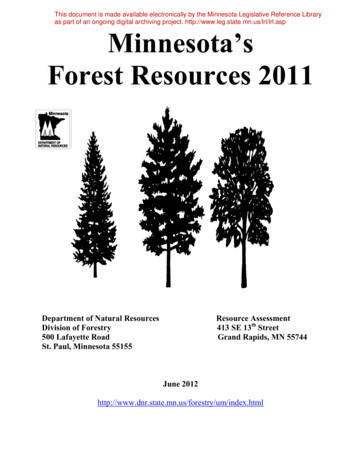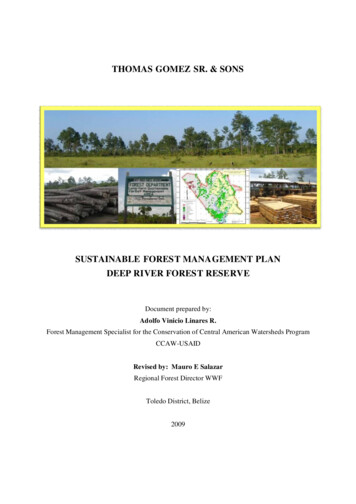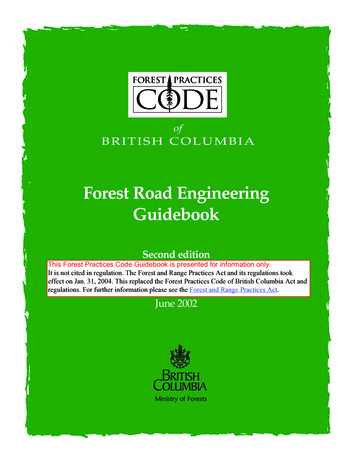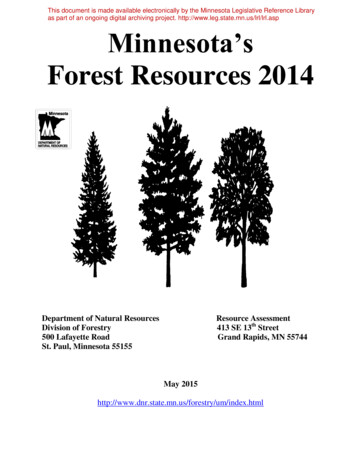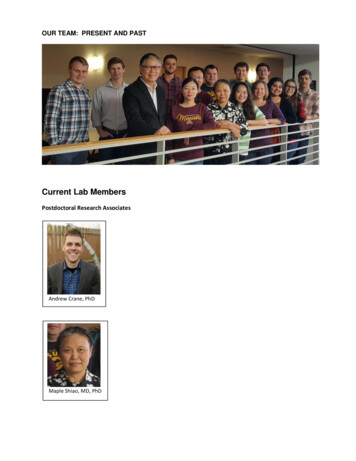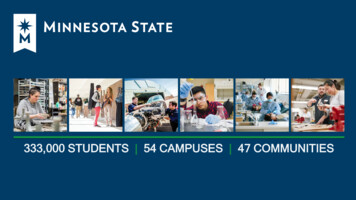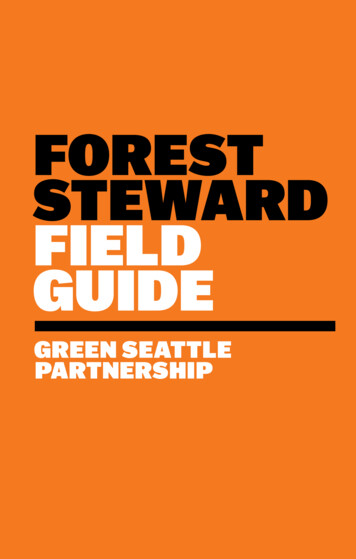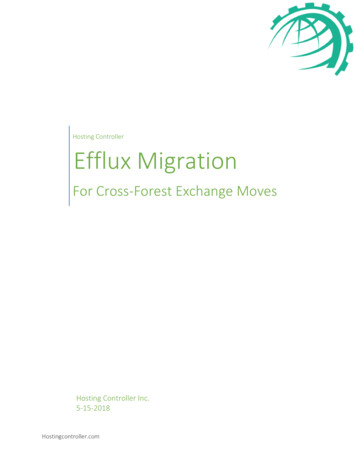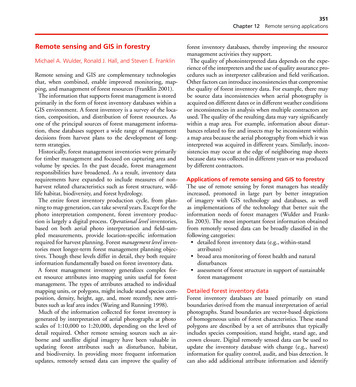
Transcription
Minnesota’sForest Resources 2011Department of Natural ResourcesDivision of Forestry500 Lafayette RoadSt. Paul, Minnesota 55155Resource Assessment413 SE 13th StreetGrand Rapids, MN 55744June tml
Minnesota’s Forest ResourcesRevised 06/12PrefaceThis report is compiled annually by Minnesota DNR – Forestry Division, Resource Assessment andUtilization & Marketing Program staff. Publication began in the mid 1980s by John Krantz, formerUtilization & Marketing Program Coordinator. The report is intended to answer frequently asked questionsabout Minnesota’s forest resources such as: current conditions and trends in forest resources, and forestresource industrial use. Foresters, other natural resource managers, planners, people employed in forestindustry, and forest policy makers will find items of interest in these pages.We thank those who cooperated in providing and updating information for this report. They include manyof Minnesota’s wood product companies, Minnesota DNR staff (particularly Don Deckard, AnnaDirkswager, and Steve Vongroven), and the USDA Forest Service Forest Inventory and Analysis (FIA)unit. Useful comments were received from Kent Jacobson, DNR Timber Sales Business Consultant, andAlan Ek, University of Minnesota. Without their cooperation and assistance this report would not bepossible.Highlights:Mill Changes: Mill shutdowns, slowdowns and curtailments continue to have a large impact on timbermarkets in Minnesota. Harvest levels of 2009 are down by nearly 1 million cords compared to 2005levels, resulting in opportunities (and need) for additional utilization and management of Minnesota’sforest resources.Timber imports of pulpwood into the state as well exports out of the state saw decreases in 2009. Thisis in contrast with the previous year for both imports and exports. It is likely that Minnesota is still anet importer of raw wood as of December 2011, but by a greatly reduced margin as compared to levelsof seven years ago.Overall net growth for all species continued to outpace harvest levels. According to 2010 FIA figures,annual net growth of growing stock on timberland was approximately 5.6 million cords,with mortalityof approximately 4.0 million cords. According to Draft 2009 mill and fuelwood survey data, thevolume of wood harvested and utilized by industry and fuelwood users was approximately 2.73 millioncords. Hence, there are significant volumes of wood above current harvest levels potentially availablefor additional harvest.Woody biomass use for energy markets and forest carbon credits are significant emerging issues thatwill have an impact on forest management in the future. Updates pertaining to woody biomass use forenergy are included in this report.Harvest levels: Total wood harvested and utilized from timberland by industry and fuelwood users inMinnesota was 2.73 million cords in 2009. Readers will also want to be aware that whileactual survey figures will not be available until later, based on analysis of millconsumption, it appears that harvest levels are within the 2.6 to 2.9 millioncord range in 2010 and 2011 .This report was compiled byCurtis L VanderSchaafForest ModelerResource AssessmentMinnesota Dept of Natural Resources483 Peterson Road, Grand Rapids, MN 55744Questions or requests for additional information can be directed to Curtis VanderSchaaf,Email: curtis.vanderschaaf@state.mn.us, or to Keith Jacobson, Minnesota DNR Forest Products Utilization& Marketing Program Supervisor; Email: keith.jacobson@state.mn.us.2
Table of ContentsPrefaceResource and Industry HighlightsContact InformationWood-Using Industry OverviewWood Energy and Woody BiomassUtilizationForest Resources OverviewHarvest LevelsSustainable Harvest LevelsWood Supply and Demand Information for Important Cover Types and SpeciesAspen/Balm of GileadBirchBalsam FirSpruceTamarackNorthern HardwoodsMapleBasswoodOakLowland HardwoodsAshRed PineJack PineWhite PineWhite CedarTimber Price InformationGlossary and Conversion 5557596265
Wood-UsingIndustryA brief overview of Minnesota’s wood-using industry, including mill location and productinformation for many of the larger mills, and total industry economic impact.4
Minnesota Wood Industry at a GlanceAnnual Economic Impact 1Value of forest products manufacturing shipments in 2009 7.8 billion.5th largest manufacturing sector in Minnesota by 2009 employment (#1 food products, #2computers & electronics, #3 fabricated metal products, and #4 machinery).Generated 7.8 percent of all manufacturing shipments and 1.1 percent of Gross State Product.Some 31,300 direct jobs comprised of: forestry, logging, and forest products manufacturing with atotal employment effect of 67,300 jobs.Some 1.4 billion in direct annual payroll.Minnesota’s forest land owners received an estimated 75 million in stumpage revenue.For wood harvested in Minnesota, the value-added impact of primary manufacturing was about 24per 1 stumpage value.Generated an estimated 430 million total state and local tax payments (sales, income, and propertytaxes).Important Industrial SectorsConverted paper products, paper & paperboard, window & door components (MN # 2 in U.S.), kitchencabinets and cabinet parts, store fixtures, wood office & residential furniture, pallets & crating, millwork,and wood shavings (for poultry industry).Non-Traditional Industries Dependent on ForestryBalsam boughs for wreath industry (annual sales of 23 million) and wood energy (14 facilities with greaterthan 10,000 cords annual consumption).1Deckard, Donald L. 2011. Minnesota’s Forest Products Industry Fact Sheet. Saint Paul, MN: Minnesota Departmentof Natural Resources, Division of Forestry.5
Value Added (Gross State Product) 2In 2009, Minnesota was ranked number 10 nationally in forest products manufacturing value added (GrossState Product) per capita.Manufacturing Facilities5 Pulp and Paper Mills3 Recycled Pulp & Paper2 Hardboard & Specialty2 Oriented Strand/Structural Board500 Sawmillso Around 30 sawmills have annual production levels greater than 2,000 cords, four sawmillshave annual production levels greater than 35,000 cords.150 Associated Specialty BusinessesOver 800 Secondary ManufacturersAnnual Volume of Timber HarvestedPulpwood 1.95 million cords (2009)Sawlogs & Specialty 247 Million Board Feet (2010) including the following specialty items:-Veneer (2007) 4.5 Million Board Feet (domestic), plus 0.6 Million Board Feet (exported)-Shavings (2007) 11,000 Cords (animal bedding)-Posts & Poles (2007) 8,000 CordsFuelwood 196,000 cords live trees from timberland (2007-08)2Compiled by Donald L. Deckard from data retrieved on 12/6/2011; source U.S. Department of Commerce, Bureau ofEconomic Analysis at http://www.bea.gov/iTable/index regional.cfm .6
Minnesota Pulp and Paper – 2011FirmWood UsedProductUPM - Blandin Paper MillGrand RapidsBoise White Paper, LLCInternational FallsAspen, Balsam Fir, Basswood,SpruceAspen, Balm, Pine, Spruce, BalsamFir, Birch, Tamarack, Ash, MapleVerso PaperSartellNewPageDuluthAspen, Balsam Fir, SpruceSAPPI North AmericaCloquetWausau PaperBrainerdAsh, Aspen, Birch, Maple, PineRock-Tenn CompanySt. PaulNewPageRecycled Fiber MillDuluthLiberty Paper CompanyBeckerRecycled Paper & CorrugatedCardboard and corrugated boxesHigh Grade Office Paper &Computer PaperMarket pulpRecycled Paper & CorrugatedCardboard and corrugated boxesBalsam Fir, Pine, SpruceMarket PulpRecycling MillsLightweight coated publicationpapersOffice papers, label and releasepapers, base sheets, business andspecialty printing gradesCoated and uncoated publicationpapersUncoated, lightweightsupercalendered magazine andpublication papersCoated freesheet fine printing andpublication paper, market pulpTape backingMinnesota Oriented Strand Board and Engineered Wood Products – 2011FirmWood UsedLouisiana-PacificTwo HarborsNorbordBemidjiProductAspen, Balm, BirchOSB – engineered siding panelAspen, Balm, Birch, MapleOSBMinnesota Hardboard and Specialty – 2011FirmInternational BildriteInternational FallsGeorgia-Pacific Corporation,Superwood DivisionDuluthWood UsedProductAspen, Balm & Recycled PaperSheathingAspen, Pine, Mixed HardwoodsIndustrial hardboardFor additional information about sawmills, pulp and paper mills, Oriented Strand Board mills, veneer mills,and dry-kiln facilities in Minnesota go to the following website and click on the Minnesota Primary ForestProducts Producer Directory html7
Minnesota Large Sawmills – 2011Mills Exceeding 3,000,000 Board Feet of Annual ProductionEconomic importanceThe saw and specialty mill sector is very important to forestry because it creates market diversity. Theapproximately 494,900 cords used annually provides high-value markets for some species, sizes, andqualities of wood that do not have high demand or are not commonly used at pulpwood-using or energymills. In addition, sawmills provide products we all use, as well as providing significant employment andeconomic benefits for many rural communities.Sawmills can also have a complementary impact on other wood industry sectors. For example, somesawmills send residue chips to paper mills, benefitting both sectors. Also, the higher-value sawlog marketcan help make logging residue economically accessible as woody biomass for energy. Finally, high valuemarkets are also important to landowners through harvest compensations, which helps them afford toengage in other management activities.There are over 500 sawmills in Minnesota, but most are small, portable bandsaw mills that account for atiny fraction of wood use. In contrast, 37 large sawmills in Minnesota utilize more than 1 million board feetannually. In fact, the top 10 mills by production volume account for over 65 percent of the total, with onelarge softwood mill accounting for about 40 percent of the total volume utilized by all specialty andsawmills.FirmWood UsedProductCass Forest Products, Cass LakeAspen, Jack Pine, Red Pine, White PineCants, LumberHawkins Sawmill, IsleMixed HardwoodsCants, LumberHedstrom Lumber CoGrand MaraisAspen, Jack Pine, Red Pine, White Pine,White SpruceLumberJarden Home Brands, CloquetPotlatch CorporationBemidjiAspen, Paper BirchBalsam Fir, Jack Pine, Red Pine, WhiteSpruceVeneerLumberRajala Mill Co.BigforkBlack Ash, Aspen, Basswood, Paper Birch, HardMaple, Red Oak, White Oak, Red Pine, WhitePine, White Spruce, TamarackBlack Ash, Aspen, Balsam Fir, Basswood, PaperBirch, Jack Pine, Red Pine, Black SpruceCants, Lumber, VeneerRoot River Hardwoods IncPrestonSavanna PalletsMcGregorBasswood, Elm, Green Ash, Hickory, HardMaple, Red Oak, White Ash, White Oak, WalnutCants, Lumber, Veneer LogsBlack Ash, Aspen, Basswood, Paper Birch,Mixed Hardwoods, Red Oak, PineBoxes or Crates, Pallets/SkidsWoodline SawmillOnamiaBlack Ash, Aspen, Basswood, Paper Birch,Hard Maple, Soft Maple, Red Oak, PineLumber, Pallets/SkidsRajala Timber Co.Deer River8Cants, Lumber
Location of mills is an important factor in determining markets for wood. The map above shows the OSB,pulp & paper, recycled fiber, hardboard, sheathing and larger sawmills in Minnesota. These mills utilizevarious species of wood material, with aspen pulpwood being by far the largest component.9
Wood Energy and Woody Biomass UtilizationWoody biomass can include entire living and dead trees, brush stems, and also residue material generatedthroughout various forest product processing steps.Woody biomass is increasingly being used in renewable energy producing facilities in the state.Wood energy is not new to Minnesota, especially in the wood manufacturing industry. However, risingfossil fuel prices, climate change concerns and other factors have resulted in wood energy marketsexpanding significantly over the past three years. The outlook is for continued expansion.The prospect of expanded woody biomass harvesting and processing has many potential benefits, including:reduced dependence on foreign energy sources, improved bottom lines for logging and processingoperations, increased opportunities for forest and wildlife management, and additional value-added productlines for the forest products industry. In fact, increased utilization of wood for bioenergy can be a tool foroffsetting forest and wildlife management costs.However, as with almost any opportunity, there are potential pitfalls to be avoided. Some of these include:impacts to raw material supply for the existing forest industry, nutrient depletion on sensitive sites, andpotential negative habitat consequences. Mitigating for potential negative effects associated with biomassharvesting must be done in order to allow woody biomass markets to expand in a sustainable andenvironmentally healthy manner. Several environmental safeguards to this extent exist and are effectivelyused in MN. These safeguards include: the Biomass Harvesting Guidelines (which MN was the first statein the nation to develop), third-party certification and MN’s Master Logger Program.Sources of Woody BiomassSome sources of woody biomass include:Logging Residue. Tops and limbs leftover from commercial timber harvest operations.“Primary” Mill Residue from sawmills, etc. Almost all is presently utilized for various products;mostly energy.“Secondary” Mill Residue from cabinet manufacturers, etc. The large majority is presently utilized.Dedicated energy crops. A very small resource in Minnesota at present.Land clearing projects. This contributes to the metropolitan wood supply for a major energyfacility.Brush from brushlands. A significant potential resource, but the economics of harvesting andprocurement technology need to improve before widespread use.Precommercial thinning, Timber Stand Improvement (TSI), Fire Hazard Reduction, and VegetationManagement Projects. A potential resource from intensified forestry and wildlife management.Urban Forests. A resource from tree clearing and maintenance and storm cleanup in urban areas.Largely used in mulch markets in major metropolitan areas as well as for energy in St. Paul.Roundwood. Given mill shutdowns and curtailments, a meaningful amount of woody biomass inthe form of roundwood has been used over the past few years.Markets for Woody BiomassWoody biomass markets normally use portions of the forest resource without traditional forest productmarkets such as tops and limbs, small diameter timber, poorly formed trees, some forms of woodmanufacturing residue, and perhaps brush.Two main factors keep small-diameter timber, tops and limbs and brush from being used for mosttraditional forest products:1) The high percentage of bark relative to wood fiber; bark fiber is not suitable for many products.2) The high cost of processing smaller-diameter material; processing efficiency is greater when using largermaterial.10
Woody biomass is a good fit for a number of products and markets including:Engineered Wood: The Georgia-Pacific hardboard mill in Duluth and the International Bildriteinsulite mill in International Falls are the two engineered wood product mills in Minnesota that takebark-on chips.Special Forest Products (SFP): Markets include log furniture, craftwood, etc. These tend to be smallvolume, but high value markets.Landscape Mulch: Markets are limited in rural Minnesota, but are significant near metropolitanareas.Animal Bedding: Animal bedding markets are limited in some of the highly forested regions ofMinnesota due to most of the poultry and dairy industry being located in the central and southernportions of the state.Energy: Energy is by far the largest market for woody biomass in Minnesota. The table belowcontains a list of some of the larger ( 100,000 oven dry tons annually) woody-biomass energyfacilities in the state.COMPANY NAMESome Large Wood-Fired Energy Producers in MinnesotaMINNESOTA POWERSAPPIMINNESOTA POWERST. PAUL DISTRICT ENERGYLAURENTIAN ENERGY AUTHORITYFIBROMINNMINNTAC TACONITE KILNCITYFUELGRAND RAPIDSCLOQUETDULUTHST. PAULHIBBING/VIRGINIABENSONMOUNTAIN IRONMILL RESIDUE, LOGGING RESIDUE, ROUNDWOODMILL RESIDUE, LOGGING RESIDUE, ROUNDWOODMILL RESIDUE, LOGGING RESIDUE, ROUNDWOODURBAN WOOD RESIDUE, ROUNDWOODLOGGING RESIDUE, MILL RESIDUE, ROUNDWOODTURKEY MANURE, WOOD CHIPS, ROUNDWOODMILL RESIDUEIn addition to the list above, there are many small medium and small wood processing companies that burn some or all of theirwood waste for heat and/or process steam.Guidelines for Woody Biomass HarvestingBecause there are important ecological and environmental reasons for leaving some residue on-site after atimber harvest, the Minnesota Forest Resources Council and the DNR developed site-level forestmanagement guidelines for harvesting woody biomass. The guidelines are available online at:http://www.frc.state.mn.us/initiatives sitelevel management.htmlForestry OpportunitiesWhat are some forestry opportunities engendered by the developing woody biomass markets?Logging Residue. In addition to local economic benefits, use of this material can, on some sites, improveease and success of regeneration and reduce fuel loading and fire danger.Forest Health Management and Invasive Species Control. Opportunities may include bark beetle control insmall diameter pine thinnings, spruce sanitation harvests to control dwarf mistletoe, and others.Brush from Brushlands. There are potential wildlife habitat benefits from brushland management.“Precommercial Thinning”, Timber Stand Improvement (TSI) and Fire Hazard Reduction. A source ofcurrently non-economically recoverable woody material is produced during forest management activitiessuch as very early thinnings and wildfire hazard reduction work. If the economics become profitable andecological concerns are addressed, the potential benefits of doing more of this work could be significant.What is the Future for Woody Biomass?Potentially, future policy trends leading toward reduced green house gas emissions and increasedrenewable energy development point toward expansion of woody biomass utilization over the nextdecade and beyond.Technologies to expand the use of biomass for increased value added products like motor fuels andgreen chemistry are edging toward commercial deployment.11
There are forestry and wildlife management opportunities engendered by expanding biomassmarkets. Research to identify opportunities is being conducted, in part by funding sources such asthe Legislative-Citizen Commission on Minnesota Resources (LCCMR).Greater use of woody biomass is an emerging issue. It will take some time to sort out on both thenatural resource management side, and also the market side. Natural resource managementconsiderations, procurement and processing systems, and markets will evolve over time.The use of woody biomass for biofuels and energy likely greatly depends on energy prices (e.g. oiland electricity) and chemical prices.12
ForestResourcesA brief overview of Minnesota’s forest resources, including total forestland and timberland acreage,cover type percentages and an ownership breakdown for timberland.13
Minnesota Acres of Land by Major Land Use2010 FIA Total Acres: Approximately ,470,497, 1%Non Forest,36,717,404,68%ReservedForestland,959,664, 2%Source: USDA Forest Service 2010 FIA DatabaseAccording to 2010 FIA data, Minnesota currently has about 15.9 million acres of forest land that isclassified as “timberland”. Timberland is forest land that is productive enough to produce a commercialcrop of trees and is not reserved from harvesting by policy or law. Reserved Forestland is land reservedfrom harvest by policy or law, including designated wilderness areas like the Boundary Waters Canoe Area(BWCA), old growth reserves, and others. Other Forestland is mostly forested land of very lowproductivity for tree growth, such that it is incapable of producing a commercial crop of trees.Minnesota Timberland Acres by OwnershipTotal Timberland Acres 15.9 l& Local18%Source: USDA Forest Service 2010 FIA DatabaseOwnership of timberland is an important factor in assessing many issues, including timber supply. Privateincludes Real Estate Investment Trusts (e.g. Potlatch Corporation), Timber Investment ManagementOrganizations (e.g. Forest Capital Partners), and integrated timber companies such as UPM Blandin andRajala Timber Company, as well as family forest landowners (e.g. individuals, families, etc.), and othernon-industrial landowners.14
Minnesota Forest Type AcreageAll OwnershipsTotal Timberland Acreage 15.9 MillionBalsam poplar3%Cottonwd Willow1%Birch6%Non stocked1%Aspen30%Lowland hdwds9%Other3%Jack pine2%Red pine4%N hdwds9%Oak9%N white-cedar4%Whitespruce1%Tamarack7%Balsam fir2%White pine1%Black spruce9%Source: USDA Forest Service 2010 FIA DatabaseForest Type: A classification of forest land based on the species forming a plurality of live tree stocking.It is worth noting that aspen is by far the largest forest or “cover” type in Minnesota.Area of Timberland in Minnesota by DNR Forest Type – 2010Forest AspenNorthern HardwoodsOakBlack SpruceLowland HardwoodsTamarackBirchRed PineWhite CedarBalm of GileadBalsam FirJack PineWhite PineCottonwood/ WillowWhite SpruceOther SoftwoodsNon-Stocked & OtherTotal All TypesSource: USDA Forest Service 2010 FIA Database*Totals may not sum due to rounding.15
Harvest LevelsInformation on 2009 timber harvest in Minnesota by product category and estimation ofcontribution by timberland ownership.16
Total Wood Harvested and Utilized by Industry and Fuelwood Users in Minnesota(In Thousand Cords - by Species – From Timberland)(Pulpwood 2009 (DRAFT); Sawtimber 2010 (DRAFT): Fuelwood 2007-08)SpeciesAspen and BalmPaper BirchFuelPulpwood* SawlogsResidential** Commercial* 227.112.4105.1Spruce228.07.40.30.1235.8Balsam .71945.0494.9196.194.12730.1MapleCottonwoodOther HardwoodSub-TotalHardwoodPineRed PineWhite PineJack PineWhite CedarOther SoftwoodSub-TotalSoftwoodTotalSource: USFS and MN DNR mill surveys & residential fuelwood survey.-Figures in chart may not total exactly due to rounding*Draft**Fuelwood removed from live trees on timberland.-Figures include cords of pulpwood exported to Wisconsin and Canada: Aspen: 36,192; Spruce: 29,404; Birch: 28,243;Maple: 22,170; Red Pine: 10,688; Jack Pine: 7,298; Tamarack: 5,115; White Pine: 4,800; Ash: 2,732; Balsam Fir: 2,289;Basswood: 1,125; Elm 937; Red and White Oak: 187; and total cords of sawlogs mainly exported to Wisconsin and Iowa of:31,200, most of which is oak and maple.Note: Actual survey figures will be available later but based on initial analysis of millconsumption, it appears that harvest levels are within the 2.6 to 2.9 million cord rangein 2010 and 2011.
Total Wood Harvest in Minnesota from Timberland1998 - 2009Million 0200120022003200420052006YearSource: Pulpwood (USDA Forest Service, Northern Research Station), Sawtimber & Fuelwood (MN DNR surveys).Estimated Volume of Timber Sold/Harvestedby Ownership-Minnesota-IndustryPrivate Land2.5Total Public LandMillion Cords21.510.5097989900'01 '02 '03 040506 07* 08* 09*YearSource: Public Lands: Public Stumpage Price Review through 2006. Beginning with 2007, annual volume scale reports(harvested) are used for State and Federal lands rather than volumes sold. Change necessary due to large volumes of reoffered wood sold by public agencies in 2007. Industry Lands: Minnesota Forest Industries estimate of harvested volumefrom 2009. Private Lands an estimate calculated as follows: Total estimated harvest 2009, minus 2009 public volumeharvested (sold through 2006), minus 2009 estimated industry volume harvested. Forest Capital Partners (formerly Boise)Timberlands contained in “Industry” totals.18
Contributors to Estimated Harvest in Minnesota 2009Total Estimated Harvest 2,730,100 cords - All Sources706758800760Thousand Cords7006005004003003002062001000Private rSource: State Lands: FY 2009 Harvest, DNR Timber Sales Annual Report. Federal: FY 2009 Harvest, Superior NationalForest Timber Statistics, and Chippewa National Forest Timber Statistics; BIA: Public Stumpage Price Review 2009 sold.County Lands: Minnesota Forest Industries survey of 2009 harvested volume. Industry Lands: Minnesota Forest Industriessurvey of 2009 harvested volume. Forest Capital Partners (formerly Boise) Timberlands included in Industry totals. PrivateLands an estimated figure as follows: Total estimated harvest 2009, minus state, county, national forest and BIA volumeharvested, minus estimated industry volume harvested.Ownership of lands has a large impact on policy regarding forest management and timber harvest.1000 CordsImports and Exports of Pulpwood RoundwoodSource: USFS Mill orts6243872722011013151184243 6200720082009YearSource: USFS Northern Research Station FIA Unit Survey of Industrial Wood Using Industry.Minnesota became a large net importer of wood from 2000 through 2006, as mill demand and stumpage pricesincreased. In 2009, mills still looked outside of Minnesota’s borders in order to meet their raw material needs,especially for aspen (91,135 cords) and maple (185,699 cords). Imports in 2009 were largely from Wisconsin(253,116 cords), with fair amounts from Michigan and Canada. Exports in 2009 were mainly to Canada andWisconsin mills.While Minnesota presently remains a net importer of timber, imports remain substantially less than 2005 levels.The change has been due to several factors, most notably reduced demand due to mill closures and slowdowns.19
Estimated Wood Use From Minnesota TimberHarvest by Primary Industry Sector 2009Total Harvest 2.73 Million CordsOSB/Engineered15%Pulp & paper56%Lumber &Specialty18%Wood Energy11%Source: Wood Use Data from Mill and Fuelwood Surveys conducted by USDA Forest Service, Northern Research Station &MN DNR. Specialty products include veneer, posts & poles, shavings & landscape chips.Wood use in the OSB/Engineered wood sector has dropped significantly since 2005, due to mill shutdowns andslowdowns.Wood use for energy has risen since 2005.Timber Harvest from Minnesota Timberlands & Utilized byPulpwood Mills 1965-20093.52.81 2.91 2.75 2.91 2.83 2.88 3.0232.232.101.8821.52.442.282.51.951.22 1.36 05'06070809YearSource: USFS, Northern Research Station SurveysA major reason for harvest leveling off in the early to mid 2000s, during a period of increasing primary industrydemand and use, was the increase in imports. Most of the imported pulpwood was aspen and maple fromWisconsin, and Canada. Imports result in fewer logging, trucking and support jobs in Minnesota. It is importantto note that a significant reduction in timber utilized by pulpwood mills, including imports has occurredsince 2005, due largely to mill closures and slowdowns.20
Volume Harvested From Minnesota Timberlands & Utilized bySawmills & Specialty Mills 2001, 2004, 2007 and 2010 DRAFTTotal Volume 2001: 302 MMBF; 2004: 272 MMBF; 2007: 248 MMBF; 2010: 247 50,0002010 Draft40,00030,00020,000All OthersCedarCottonwoodSpruceBalsam FirBlack AshSoft MapleHard MapleBasswoodWhite OakPaper BirchRed OakAspenJack Pine0Red Pine10,000SpeciesSource: MN DNR Sawmill and Specialty Mill SurveySawtimber is often the highest value product for wood that meets merchantability requirements. Generallyspeaking, a log needs to be at least 8 feet in length and 8 inches minimum diameter inside bark at the small end inorder to be of merchantable sawlog size (however, there are an increasing number of sawmills that can utilizesmaller diameter material profitably). Sawmill capacity dropped from 2001 through 2010, leveling off between2007 and 2010. Jack pine, aspen and oak use dropped off most significantly in the sawmill sector; while red pineactually showed a significant increase in use by sawmills.Fuelwood Demand* in 1197819191970060Thousand CordsUsed2000YearSource: MN DNR Fuelwood SurveysResidential fuelwood is a relatively small portion of total timber harvest.*It is important to note that only a portion of the nearly million cords of total residential fuelwood demandcomes from live trees on timberland. About 196,000 cords of residential fuelwood came from live trees ontimberland in 2008. The remainder is from sawmill residue, urban tree waste, land and power line clearing,and dead trees.21
Sustainable HarvestInformationSustainable Harvest LevelsThis section contains information on estimatedsustainable harvest levels* for many of Minnesota’s most significant tree species.*Note to readers: There is no direct correlation between current harvest levels and long term sustained harvestlevels because there are many options for moving towards a targeted forest age class structure. Normally,transitions from the current structure to a target age class structure require several rotations. The choice ofamount and timing of harvest can vary considerably by decade. Harvest plans are typically assessed periodicallyas changes to the resource,
483 Peterson Road, Grand Rapids, MN 55744 . Questions or requests for additional information can be directed to Curtis VanderSchaaf, Email: curtis.vanderschaaf@state.mn.us, or to Keith Jacobson, Minnesota DNR Forest Products Utilization & Marketing Program Supervisor; Email: keith.jacobson@state.mn.us.
